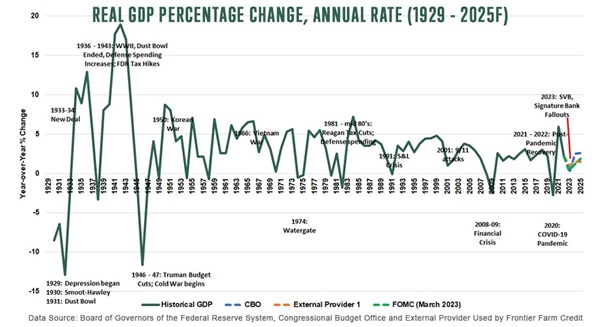The Federal Reserve has signaled its determination to tame inflation, even if it means further rate hikes in an increasingly uncertain economic environment. But recent bank failures upended financial markets. The result: We are at a major crossroads on interest rates, labor, inflation and more. Our economist, Matt Erickson, dives into the possible paths ahead to help agricultural producers better prepare for the coming year.
Fallout of March Madness in Markets
Interest Rate Outlook: Market Expectations
Yield Curve and Unemployment: What They Signal for the Economy
U.S. Dollar: Shifting Landscape
U.S. Consumption and Manufacturing Output
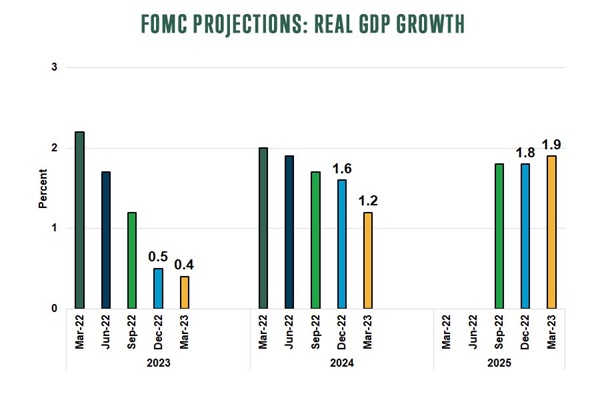
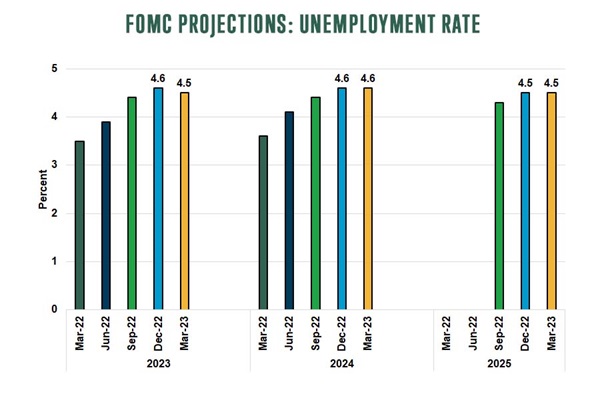
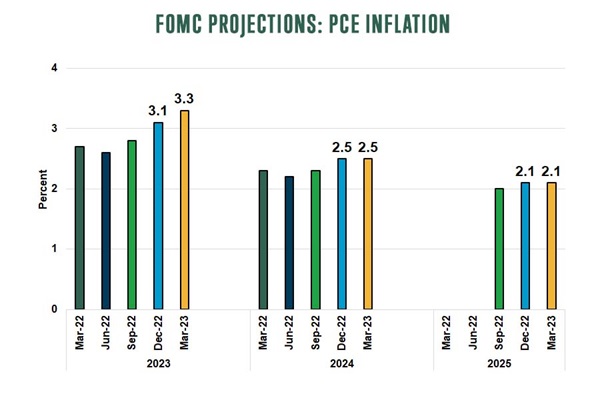
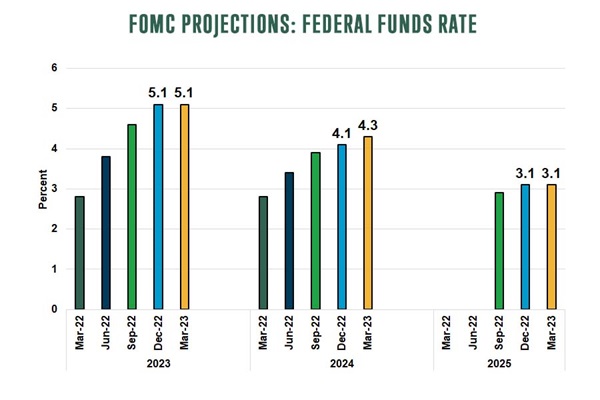
Fallout of March Madness in Markets
Summary Points
- The Federal Reserve increased its benchmark rate by 25 basis points in March. This raised the federal funds target range to 4.75% on the lower end and 5% on the higher end. This is the range highest since 2007 (View the Federal Funds Rate image below).
- The federal funds target range is near the time-series average dating back to 1954. But the pace of the current rate cycle is unmatched in the past 40 years (View the Federal Funds Rate image below).
- At its March meeting, the Federal Reserve updated its projections from December 2022: real GDP growth and unemployment likely will be lower in 2023 and inflation and interest rates will be up (just slightly in the case of interest rates).
Why This Matters
It’s amazing how quickly things can change in the U.S. economy. There have been signs in recent months that the economy was losing steam: Month-over-month retail sales in February were 0.4 % lower than January; job openings, while remaining abundant, are down and mortgage demand declined to a 28-year low at the beginning of March.
Even so, the Federal Reserve remains concerned about inflation and the tight labor market. The Core Personal Consumption Expenditures Price Index (PCE), which excludes food and energy prices and is the Fed’s preferred inflation gauge, came in at 4.6% in February. This is lower than the 4.7% reported in January, but well above the Fed’s target of 2%. Despite announcements of layoffs in the news, jobs remain plentiful, and February retail sales also came in strong year-over-year at 5.4%.
Going into its March meeting, the Federal Reserve was prepared to deliver a 50-basis-point increase to its benchmark rate. Then Silicon Valley Bank failed on March 10, followed by trouble at Signature Bank. The fallout in the market left the Federal Reserve at a strategic crossroads: Continue raising rates to get inflation down to its 2% target and risk further economic deterioration or temporarily halt interest rates to assess the economic impact, even if it means continued inflation.
Economic data will drive the decision in the end. But the Federal Reserve did back off its expected rate hike and delivered a smaller 25-basis-point increase at the March meeting. Does this difference suggest that the Federal Reserve views the banking crisis as worth 0.25% of 1% of the federal funds Rate? Not necessarily. Rate hikes are the Fed’s tool for tightening monetary policy. Trouble in the banking sector has had a similar effect, tightening credit conditions for households and businesses.
The March hike sent a signal to the market that the Federal Reserve is determined to lower inflation, perhaps to a greater degree than many observers thought. There is evidence to support this. Every quarter, the Federal Reserve leadership shares views on where it sees the economy trending in the next few years. Leaders look at several key variables, including real GDP, the unemployment rate, inflation (PCE) and interest rates (federal funds rate).
The above chart shows that, collectively, Federal Reserve officials see slower economic growth, lower unemployment and higher inflation in 2023 (orange columns). The Fed also suggests interest rates will tick up slightly to 5.1% for 2023. This leaves room for an additional 25-basis-point increase. Four (4) of the 18 officials surveyed see rates higher than 5.5 %; only 2 officials expressed this view back in March. The Fed projected no rate cuts until 2024, when it forecast a drop to 4.3%.
The markets have a different view. According to the CME FedWatch Tool, the highest level of confidence for 2023 suggests rates settling at the current target range of 4.75% and 5% through the Fed’s June meeting and dropping in stair-step reduction by a total of 50 basis points by December. This would put the rate at the end of the year at 4.25% on the lower end and 4.5% at the upper range.
Time will tell how the market plays out, but Federal Reserve Chairman Powell said in testimony to Congress in March “. . . the process of getting inflation back down to 2% has a long way to go and is likely to be bumpy.”
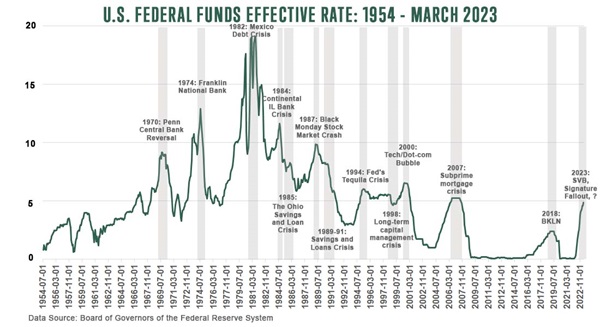
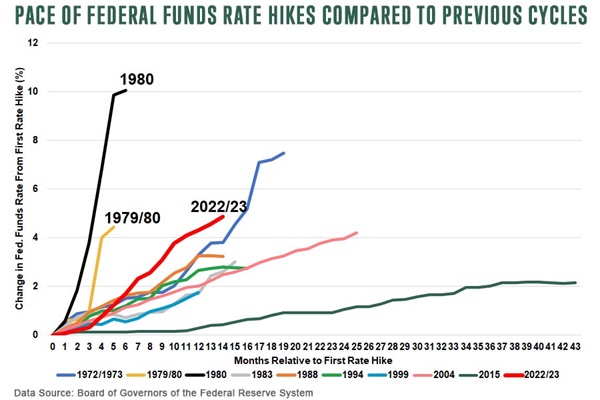
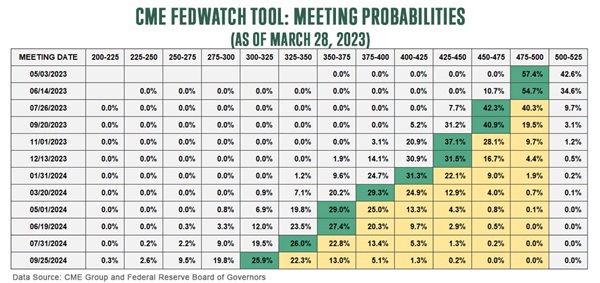
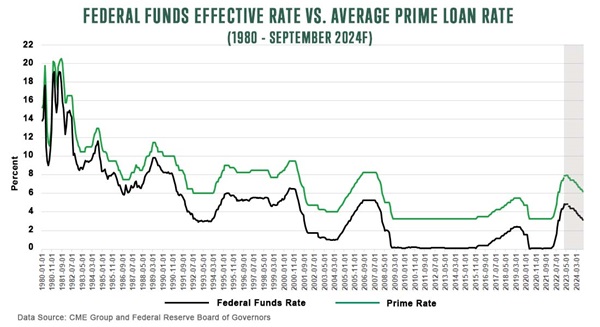
Interest Rate Outlook: Market Expectations
Summary Points
- The Federal Reserve projections indicate the federal funds rate target range will peak at 5% on the lower end and 5.25 % on the upper. The market is pricing in 50 basis points worth of cuts into the federal funds rate by the end of 2023 and projects a peak range between 4.75% and 5%.
- The Feds and the markets agree that economic growth is likely to decelerate in the months ahead and uncertainty created by bank failures will be one more variable for the Federal Reserve to manage.
Why This Matters
In testimony to Congress, Reserve Chairman Powell testified in early March that economic data continued to come in stronger than expected and to tamp down inflation, the federal fund rate could climb higher than previously anticipated. This led some to speculate rates could reach 6%.
Following the recent bank failures, the Federal Reserve softened its language on the need for further rate hikes and cautioned that financial headwinds could lie ahead. Many have called for rate hikes.
All this happened during March, underscoring the futility of trying to “out guess” the market and instead staying focused on market data and financial fundamentals. The bond market is one area to watch. Long-term rates are determined by market forces. When there is a perception that the federal funds rate is too low, markets expect inflation. Long-term interest rates go up to compensate for the loss of potential purchasing power associated with the future cash flow of a bond.
The CME FedWatch Tool is a probability chart that measures the market’s confidence regarding the direction of federal funds rate. The spread between the federal funds rate and the prime rate also is worth monitoring. The prime rate, a general guide for consumer lending, is influenced but not determined by the federal funds rate. Based on the 30-year historical spread, the prime rate on average is 3.06% above the federal funds rate.
If the peak target range for the federal funds rate is forecasted between 4.75% and 5% (which it is, as indicated in the chart above) and the historical spread between the prime and federal funds rates holds, then the average prime rate could be between 7.75% and roughly 8%.
It’s important to work with your Farm Credit financial team to stay current on the overall interest rate environment and understand what it means for your operation. Interest rates can vary from producer to producer and there may be options for managing interest rates costs.
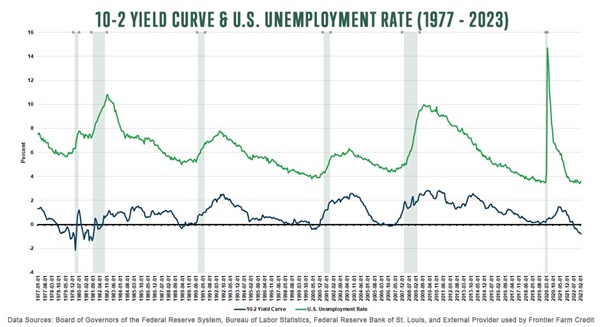
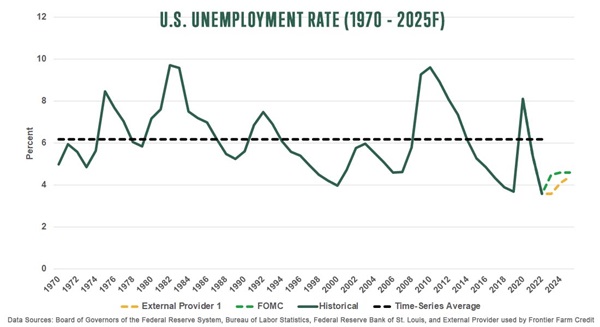
Yield Curve and Unemployment: What They Signal for the Economy
Summary Points
- The U.S. unemployment rate has been under 4% for 13 consecutive months, identical to 2019 into February 2020, when COVID disrupted the economy.in the U.S. in February 2020). The February 2023 unemployment rate, which was reported in March, was 3.6%, up slightly from January’s 3.4%. The U.S. hasn’t seen a longer and more persistent unemployment rate since 1967 and leading up to the recession of 1970. Then, the unemployment rate fell below 4% for 27 consecutive months.
- For each of the past eight months, the yield curve has been inverted, meaning shorter-term yields on bonds are higher than longer-term yields. Historically, when this event occurs, it sends a recession signal to the market.
- In the wake of recent bank failures, the inverted curve began to climb, or “re-steepen”. The de-inversion of the yield curve can signal a more imminent recession signal. Since 1980, an average of nine months has lapsed from the point of de-inversion and the onset of recession.
Why This Matters
The Federal Reserve has a dual mandate: Promote maximum employment while also keeping prices stable for consumers and businesses. This is a delicate balancing act. From today’s market standpoint, we have unsustainably low unemployment, which is contributing to inflation.
Monetary policy generally tightens in this kind of environment. In fact, we have seen the Federal Reserve aggressively increase the benchmark interest rate by 19, 25 basis points since early 2022. As recently as February and into early March, the Federal Reserve indicated it had more work to do to cool the labor market and bring inflation more in line with its 2% target. But recent bank troubles have complicated the Federal Reserve’s position on rates. Here, we look at the factors that could shape rates – and the economy – in the months ahead.
The U.S. unemployment rate has been below 4% for 13 consecutive months. This isn’t unprecedented. It happened as recently as 2019-2020, when the 13-month streak was broken by the arrival of the COVID pandemic. But it has been more than half a century since the U.S. has seen the unemployment rate as low and entrenched as todays. Consider the January unemployment rate of 3.4%. The last time the rate was this low was May 1969, part of a 27-month string of sub-4% unemployment that culminated in the recession of 1970.
The February unemployment rate was up slightly to 3.6%. Markets read this as a signal that the Fed monetary policy could be having the desired effect. However, 419,000 people also entered the labor force, bringing the labor force participation rate up to 62.5%.
Job openings are another important metric. The U.S. had roughly one job opening for every unemployed person since May 2021. Today, the latest data shows 1.9 jobs for every unemployed person. While January job openings were 9% below the March 2022 peak, they remain 55% above pre-pandemic levels.
The “war for talent” continues to exert pressure on wages. But actual pay increases offer another positive signal on the inflation front. Average hourly earnings climbed 4.6% year-over-year in January, a monthly increase of 0.2%, or half what the market expected.
One of the best indicators (and frankly predictors) of inflation and the direction of the economy is the bond market. Since July 2022, the rate on the 10-year Treasury minus the rate on the two-year Treasury (i.e., the 10-2 yield curve) has been negative, meaning interest rates on longer-term bonds are lower than on shorter-term bonds. This happens as the market becomes more pessimistic about the economy in the shorter-term.
On March 8, just ahead of the deposit run on troubled Silicon Valley Bank, the 10-2 yield curve inverted by more than 1%, the steepest inversion since the 1980s. By March 10, as markets reacted to the failure of Silicon Valley Bank, interest rates on the 10-year Treasury fell to 3.38% from 3.7%. Interest rates on the two-year Treasury had fallen nearly a full percent by March 23, from 4.6% to 3.76%. Silicon Valley wasn’t alone in its challenges and in the second and third weeks of March, the yield curve re-steepened at the fastest rate since December 1980. The bond market was signaling that the current rate hike cycle could be coming to an end.
Prior to March, when the Federal Reserve signaled further rate hikes to rein in employment and economic activity, there was talk of the Fed Funds rate reaching a potential peak rate of 6%, up from their December economic projection of a peak rate of 5.1%. The Fed did increase its benchmark interest rate by 25 basis points at its March meeting, while also signaling it was a “dovish” hike rather than a “hawkish” pause. Like the markets, the Fed acknowledged the rate-hike cycle could be coming to a close. If true, the inversion of the yield curve also could be in the past.
So, what would this mean? Past performance is no guarantee of future results, but history serves as a valuable guide for identifying trends and market signals. Since the 1970s shows, the inversion of the yield curve typically is followed by recession. Data also suggests that when the yield curve un-inverts, or re-steepens, recession can be more imminent. Since 1980, the average time from the start of de-inversion to recession has been nine months (ranging from two months prior to the 1981 recession to 13 months before the 2007/08 recession).
The relationship between inverted curves and recession isn’t one of cause and effect. Rather, inverted curves are but one of many signals on the direction of the economy, and yes, false positives can exist.
Historical trends also suggest that recessions occur when the unemployment rate increases. However, it is worth noting that unemployment numbers are a lagging economic indicator, while the bond market is in real-time. The green line on the chart to the right indicates the Federal Reserve projects an unemployment rate of 4.5% for 2023. Since its unemployment projections are for the fourth quarter of each indicated year, at a current rate of 3.6%, the Fed is expecting the unemployment rate to increase by almost a full percentage point.
It is clear the Federal Reserve expects a bumpy road ahead and the labor market to cool substantially. Rising interest rates have increased the cost of capital. This has led businesses and consumers to reduce capital spending, particularly with variable interest rate debt such as credit cards. This, alone, has a direct impact on agriculture.
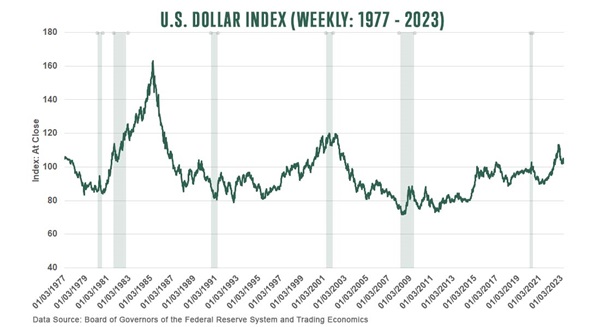
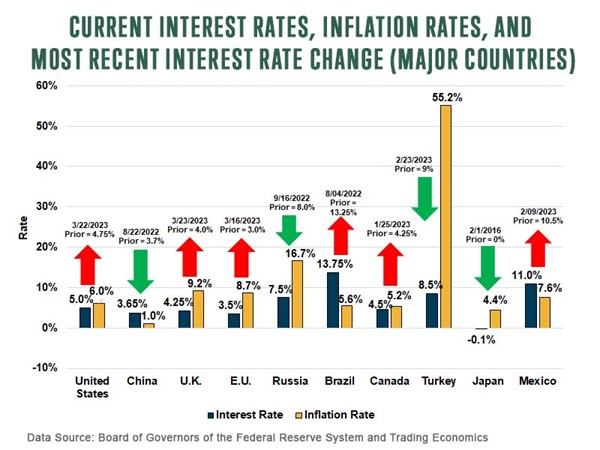
U.S. Dollar: Shifting Landscape
Summary Points
- The U.S. dollar has appreciated in the current cycle of interest rate hikes. Last October, the index was at its highest point in 20 years. In the wake of bank troubles, the U.S. dollar index weakened, ending about 2% down compared to February.
- In the short-term, higher-than-expected inflationary pressure could mean a continued hawkish stance on the federal funds rate and a strong U.S. dollar. If growth slows as a result of the Feds’ tighter monetary policy and interest rates peak, pressure on the dollar could ease.
Why This Matters
A stronger dollar is both good and bad for the U.S. economy. It makes U.S. commodities more expensive to foreign buyers and U.S. exports suffer as result. At the same time, because global commodities are priced in U.S. dollars, it costs more to purchase commodities such as oil with currencies other than the U.S. dollar and demand for the commodities drops.
Around the middle of October 2022, the U.S. Dollar Index peaked at its highest level since 2002, and has been trending down since the end of March.
Where the strength of the U.S. dollar against other currencies has declined compared to last fall, the exchange rate has tightened. Canada and Mexico, key trading partners for U.S. agriculture, recently raised their interest rates to slow their countries’ inflation. The same rate-hike trend is playing out with central banks across the globe, as shown in the chart to the right.
In broad terms, Mexico’s peso has strengthened against the U.S. dollar. As of March, the exchange rate was 18.5 pesos to 1 U.S. dollar compared to 20 pesos to the dollar in July 2022. The Canadian dollar has stayed relatively even since September at 1.37 to 1 U.S. dollar.
This shift could impact trade patterns. While last fall’s strong dollar supported U.S. import purchasing power and constrained U.S. export sales, a weaker dollar in a slowing U.S. economy could support U.S. agricultural exports.
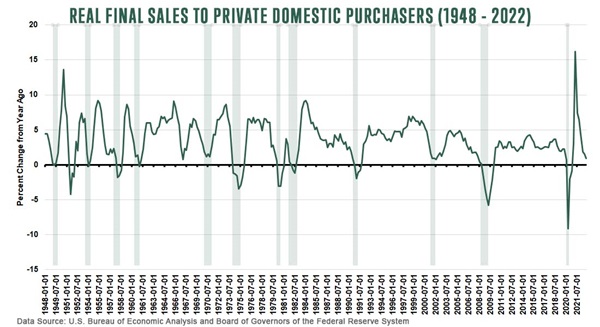
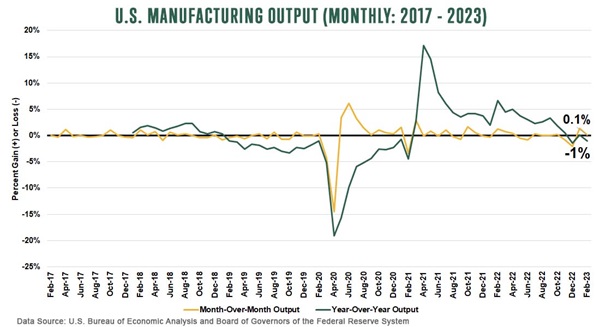
U.S. Consumption and Manufacturing Output
Summary Points
- U.S. manufacturing output increased 0.1% from January to February while output fell 1% on a year-over-year basis. The manufacturing sector continues to struggle with higher interest rates.
- Generally, consumption makes up roughly 70% of U.S. GDP. For quarter four of 2022, real final sales to the private sector barely grew at 0.9% year-over-year. The lack of growth is a concern; a strong consumer is needed for a strong economy.
- The Federal Reserve lowered its estimate for real GDP growth in 2023 to 0.4 % (measured as a percent change from the fourth quarter of last year to the fourth quarter of 2023). The “Real GDP” shows baseline the Congressional Budget Office (CBO) and a private external provider used by Frontier Farm Credit. Each show slower economic growth in 2023 -- at 0.1% and 1%, respectively.
Why This Matters
Consumption and manufacturing are two important variables to the U.S. economy. Consumption makes up roughly 70% of U.S. GDP, while manufacturing’s share of real GDP generally ranges between 11% and 13%. The latest data suggests higher interest rates and tighter credit are taking a toll on both manufacturing and consumption.
The chart on the left shows quarterly data of real final sales to the private sector from 1948 through 2022. The gray bars indicate historical recessions. Year-over-year growth from quarter four of 2021 to quarter four of 2022 was only 0.9%. Historically, real final sales growth this low is associated with recession, the only exceptions being quarter three of 1951 and quarter two of 1967.
Even as consumption is down, U.S. consumers are taking on more debt. Total consumer debt hit a record high of $16.9 trillion at the end of 2022. Low unemployment has kept the consumer in a relatively strong position. However, higher prices and interest rates are testing borrowers’ ability to repay debt. Delinquency on the total debt balance remains low, but it is trending up on credit card, auto loans and mortgage debt. A strong consumer is generally a requirement for a growing economy, and this will be a data point to watch in 2023.
Meanwhile, U.S. manufacturing output continues to slow due to higher interest rates. The chart on the right shows manufacturing output rose 0.1% from January to February while year-over-year output fell 1%. Other data points suggest the same. The ISM Manufacturing Index, a monthly gauge of economic activity in the manufacturing sector, was 47.7 for the month of February. Fifty is the cutoff point between growth and contraction. It has been below 50 (contraction) for four consecutive months.
On a regional basis, the Federal Reserve Banks of Chicago and Richmond provide indexes of economic health of their respective manufacturing sectors. The Chicago Purchasing Manager’s Index was 43.6 in February, down from 44.3 in January, indicating a continued state of contraction (an index of 50 is the line between contraction and expansion). The Richmond Federal Reserve Bank’s Manufacturing Index was -16 in February. It remained negative in March but improved 11 points on new order and employment numbers.
It is clear manufacturing and consumption are showing signs of slowing. It will be important to watch how these two variables respond to if the unemployment rate climbs as that are expected in 2023.
